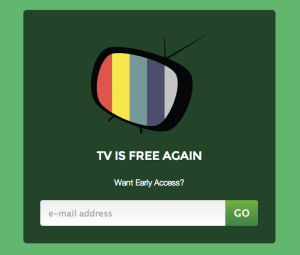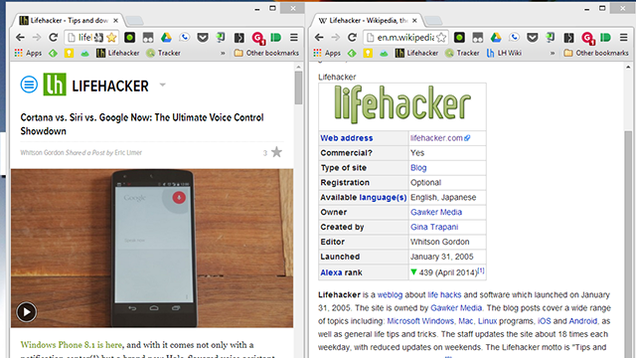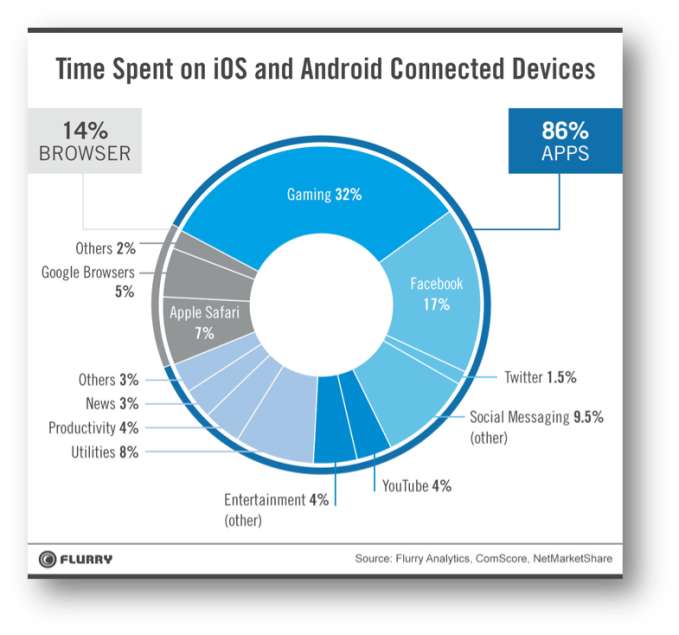Mobile TV has never been a thing. Since the Sony Watchman in 1982, we’ve been excited at the prospect of mobile TV, but no matter how good our devices are, there still seems to be something missing. As recently as this January, Josh Elman noted to John Borthwick that the results of the Homescreen 2014 study show that even now, no one keeps mobile video apps on their smartphone homescreens; we don’t even give YouTube or Netflix top billing.
That is not to say that those two apps don’t generate an enormous amount of mobile video views. But interestingly, they have not increased the average time spent watching video on mobile devices to a point where it threatens traditional TV sets.
You might say: Why do we care about watching TV on mobile devices when I’ll likely just watch TV on my biggest screen? I’m not arguing that the TV-viewing experience could ever be preferable on a mobile phone, but I do think that the discovery of content can and may already be better on mobile. Mobile might have the right set of constraints to require a real change in user experience, if not the underlying content recommendation technology.
As a result, video consumption on mobile is currently at two extremes: 1) slowing your scroll to wait for six-second Vines to load while you’re on the toilet, and 2) time-shifting massive TV series from the home when we need to prolong our life-threatening drama binges on our commutes.
The mobile televised revolution
The first mobile TV revolution happened before the iPhone from around 2005-2008 when a few measly million early adopters started double-paying for either MobiTV, MediaFLO from Qualcomm or VCast from Verizon Wireless.
One of the biggest businesses when the CTIA Wireless shows were still kind of a big deal was for TV networks to meet with mobile carriers to discuss TV content licensing deals. However, once the iPhone took off, we forgot all about mobile TV and watched the dawn of mobile video, powered by YouTube searches and Facebook and Twitter shares that enabled the Gangnam-style, billion-view explosions of 2012-14.
Now, nearly 10 years later, it might be time to tune in again. First, we need a distinction between what we mean when we say “video” versus “TV.”
Mobile might have the right set of constraints to require a real change in user experience, if not the underlying content recommendation technology.
“Video” is when you watch the one thing that someone else told you to watch. “TV” is a broadcast concept. Let’s call TV a time-based experience when you turn on a TV on the wall, computer or phone, and just start watching. The catch with TV for the consumer is that it shouldn’t be hard to change the channel and you shouldn’t have to know what you want to watch before you turn on the TV.
The TV experience becomes worthwhile to producers when consumers spend enough time watching TV that they see more than one video in a session, so there can be commercial breaks rather than pre-roll ads. With cable TV interfaces, channel changing is not worth the effort as the 1980s-90s pastime of flipping channels has devolved into scanning bloated menus that look like Microsoft Project and are not conducive to navigating with a remote control.
However, search is not the key to finding shows that you’ve never heard of before. For example, searching for “really good new TV” makes no sense, and automated recommendations are still not satisfying. In fact, the whole search model on desktop has been an easy target for companies like Aol and Turner to game results by featuring videos on well-trafficked pages or through SEM and SEO to get more views for videos that may or may not be the best or most relevant to watch.
The NYTimes’ David Carr mused recently that the universe of quality TV content is expanding at an ever-increasing rate. The new Netflix model of laying out full seasons of TV dramas that are suspenseful enough to get you to binge watch is only the beginning of an explosion of quality content.
Frederic Guarino, head of BD for Montreal-based boutique film production strategy and finance firm MediaBiz, considers this the moment before a global tidal wave of newcomers will start to compete with traditional U.S.-based TV networks. Amazon, Walmart-Vudu and Apple will be followed quickly by international players like Canal+, iTV, Scandinavia’s SVT and DR, and possibly even China’s Alibaba. “Your average TV series buff is now drowning in quality content and not necessarily able to find all of it.” So if there’s all these shows just lying around but no one company owns the best content suggestion interface, what will the industry do to solve that problem?
As Jim Barksdale says: “Two ways to make money in business: you can unbundle, or you can bundle.”
Cashing in on mobile TV
YouTube has succeeded in unbundling TV into mobile video, while multiple system operators (MSO) are trying to take bundled video to mobile and call it TV. MSOs like Verizon and Comcast carry with them nearly all the quality content creators via the television networks, and access to that content comes at a licensing and authentication cost across your devices. In its Q4 2013 Digital Index, Adobe said that iPads, iPhones, and iPods produce nearly 50 percent of play requests for TV Everywhere content.
I asked someone from the original MobiTV team about his experience in 2014, particularly as a parent, in attempting to unlock mobile TV for his family:
TV Everywhere has absolutely succeeded in that it’s enabled the media guys to keep their content behind a paywall without double-charging anybody; that was one of the issues with a MobiTV subscription, you had to buy your mobile content separately from your existing cable package. However you need to authenticate with your MSO on every device you want to use, which requires your Verizon username and password you got the day they hooked you up…and probably haven’t used since. In practice, you install the app on your iPhone or iPad, forget about it, and then when you actually want to use it you fire it up and have to authenticate it, which takes a couple minutes so it kills the instant gratification factor.
The MSOs and YouTube both may be too big to create an enjoyable new experience for mobile TV. 5by.com, which was recently acquired by Stumbleupon, uses a mood selector to automatically queue up video categories, and it does a great job of making sense of the vastness of YouTube content that’s out there that would otherwise never be watched. Shelby.tv, Frequency and ShowYou add socially shared videos from Facebook and Twitter to signal which videos should come into your playlist, and they use explicit interactions within their apps such as likes to discern popularity.
The biggest company that is aggressive in this space is Yahoo with two strong offerings made for mobile TV. The acquisition of Tumblr now has given Yahoo a machine for social referrals to TV tune-in. In the same Adobe Q4 Index report, we see that “half of visits referred from Facebook or Tumblr to sports related sites result in a video view.”
The Tumblr team has also found that TV brands are getting serious tune-in through animated GIFs. Sima Sistani, director of media at Tumblr, considers this behavior totally normcore. ”Let’s say I’m in my Dashboard, and I see a hysterical GIF from Jimmy Fallon’s latest rap battle. Now I’m captivated, and I click through to watch a video on his site. In an on-demand world, tune-ins can happen at anytime.”
Something has to change to make watching more than one video at a time enjoyable on mobile.
Yet, even with high growth, only 6 percent of video starts come from social media referrals, and it seems to be limited to destination TV, such as live events or well-advertised dramas. Yahoo Screen is the company’s mobile TV pure-play product, and Marissa Mayer has written a huge check to NBC so that Yahoo Screen can stream the back catalogue of SNL. However, the challenge remains that if all you really want to do is watch a show that everyone knows, like SNL, then Yahoo still needs to solve the discovery challenge for the rest of its content, especially the non-sports ones like comedy.
When I asked if Facebook, and other social networks would just soon look more like TV platforms, founder and CEO of 5by Greg Isenberg said that wouldn’t likely happen without Facebook launching a new app, because mobile apps need to provide single-purpose user experiences.
For example even Facebook’s Paper, which only changed the reading navigation experience on Facebook, was different enough to require a new app so as not to cause a revolt from the user base. But something has to change to make watching more than one video at a time enjoyable on mobile. It’s possible that one of the things that holds mobile TV back, the fact that when using a smartphone you actually have to hold the screen with the same hands that you use to type, could inform a subtler UX that takes implicit metrics like “seen” instead of “tapped-on.”
If you look at the newest crop of mobile TV apps, a new, accepted interface for them is starting to solidify. All apps are moving toward minimizing the user interface into simple video players that show videos full screen and feature “tap to pause” and “swipe” to change channels. However there are slight differences in the UX of each of these apps, and one company that has yet to officially launch, called EndlessTV, thinks that its UX recipe can help it take the Pandora genome idea for music, and adapt it to fit your mobile TV.
A new model for broadcast TV
Once called Tip or Skip, a “Hot or Not” for products, the team at EndlessTV pivoted last year to experiment with video. Over the past six months, they’ve deployed 15 interest-based TV channel apps that would help them create and analyze content communities. Additionally, when EndlessTV launches its flagship app at the end of this month, it will use implicit metrics, such as average engagement time and percentage-viewed thresholds — instead of industry-standard metrics for video views, likes and shares — to power its content-suggestion genome.
The company’s hope is that these engagement-based metrics paired with interest-based channels will make automation watchable. Also, they found that the one big difference between trying to make a genome for TV rather than music is that in many cases, especially for news, TV requires an expiration date on certain content.
 While watching the data from their 15 apps and 250,000 downloads, which are mostly on iOS, EndlessTV’s other job has been to woo TV producers to give them quality content for free, before it unifies its content into a single app offering. So, the mission of the new, bundled, Voltron of an app is to achieve the ultimate balancing act in promising users that “TV is free again” and promising TV producers that free TV is lucrative again.
While watching the data from their 15 apps and 250,000 downloads, which are mostly on iOS, EndlessTV’s other job has been to woo TV producers to give them quality content for free, before it unifies its content into a single app offering. So, the mission of the new, bundled, Voltron of an app is to achieve the ultimate balancing act in promising users that “TV is free again” and promising TV producers that free TV is lucrative again.
“EndlessTV shares revenue with its content partners based on how long viewers watch their content, rather than how many interruptive ads are served,” Michael Weiksner, CEO of EndlessTV, explained. “This creates a positive feedback loop where viewers get better and better content, and content partners get better distribution and monetization for creating engaging content.”
To make sure that they solve for the business case, EndlessTV made a couple of interesting design choices for the app in the name of advertising and for getting the cleanest data for feeding their mobile TV genome. EndlessTV omitted the timeline scrubber from videos so, by design, you can’t adjust where you are in the video, and it removed all mention of the titles of what you’re watching.
By making sure that users only start from the beginning of videos, they have an idea of how engaging each video is based on both crossing a relevant threshold in the clip and time spent on each particular clip and can say to TV producers, ‘give us your most engaging videos’. Like their competitors, on EndlessTV ads would only show up in-between videos as commercial breaks instead of via pre-roll.
Also, by requiring a user to tap to pause the video before they can identify the video’s title, EndlessTV gets an additional display ad space on half of the screen for a standard 300 x 250, but doesn’t have to resort to overlays or interruption of content. Their favorite stat is that after they turned on their nascent mobile TV genome they were able to extend the session time of its users versus a control group by 3x.
The measure of success for EndlessTV and its other mobile TV competitors is to be able to monetize better than YouTube, so the bar is actually pretty low. But as Netflix grows in its subscriber base and continues to collect massive amounts of data, while keeping subscription prices low, these free mobile TV apps might prove an ally to TV networks and independent producers as they rethink their alliances with MSOs and consider their own direct to consumer offerings. Proving a concept like mobile TV is hard, so any success, like getting users to have a favorite app for their homescreen would be a major victory.
Image by Maksim Kabakou/Shutterstock



















 Holding the reins when it comes to data usage is essential in these LTE/download booster times. / © AndroidPIT
Holding the reins when it comes to data usage is essential in these LTE/download booster times. / © AndroidPIT The Galaxy S3 on Android 4.3: set mobile data limit. / © AndroidPIT
The Galaxy S3 on Android 4.3: set mobile data limit. / © AndroidPIT The Galaxy S4 on Android 4.4.2: business as usual for setting a data limit. / © AndroidPIT
The Galaxy S4 on Android 4.4.2: business as usual for setting a data limit. / © AndroidPIT The Galaxy S5 on Android 4.4.2: slightly different look thanks to the new TouchWiz. / © AndroidPIT
The Galaxy S5 on Android 4.4.2: slightly different look thanks to the new TouchWiz. / © AndroidPIT


















 While watching the data from their 15 apps and 250,000 downloads, which are mostly on iOS, EndlessTV’s other job has been to woo TV producers to give them quality content for free, before it unifies its content into a single app offering. So, the mission of the new, bundled, Voltron of an app is to achieve the ultimate balancing act in promising users that “TV is free again” and promising TV producers that free TV is lucrative again.
While watching the data from their 15 apps and 250,000 downloads, which are mostly on iOS, EndlessTV’s other job has been to woo TV producers to give them quality content for free, before it unifies its content into a single app offering. So, the mission of the new, bundled, Voltron of an app is to achieve the ultimate balancing act in promising users that “TV is free again” and promising TV producers that free TV is lucrative again.





